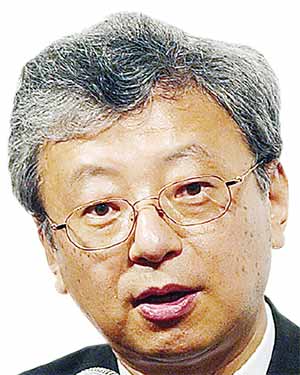13:30 JST, December 8, 2023
The yen has been undergoing an unprecedented decline.
Not only has the yen’s nominal exchange rate — which most people are familiar with as it is regularly established on the foreign exchange market — been hovering at nearly ¥150 against the U.S. dollar, but its real value has decreased sharply. This fall in real terms has been caused by the fact that Japan’s consumer prices and wages have posted almost no increase due to more than 20 years of deflation in the country.
The dip in the yen’s nominal exchange rate and the decline in its purchasing power — the amount of goods and services that a single monetary unit can buy — stemming from the prolonged price and wage stagnation have triggered a variety of phenomena.
In New York, a bowl of ramen reportedly costs even $20 (about ¥3,000). As such, to Japanese people, prices abroad appear to be very expensive. But it cannot be said that this ramen price is high for New Yorkers as the minimum wage is $15 per hour. People visiting Japan from abroad, for their part, feel that prices of goods and services here are very low. This is a tailwind for boosting inbound tourism to Japan.
The extreme weakness of the yen has helped Japanese exporters increase their price-competitiveness and net good profits. On the other hand, a weaker yen makes imported food and energy expensive, eventually pushing up domestic prices.
Rebound ahead?
The yen was trading at around ¥115 against the dollar in February 2022, but eight months later, in October of the same year, it plunged to ¥150 to the greenback owing to a spate of sharp interest rate hikes by the U.S. Federal Reserve. The widening of interest rate differentials between Japan and the United States prompted cross-border capital flows to move into dollar-denominated assets, sending the yen sharply lower and the U.S. currency higher.
Foreign exchange rates strongly reflect the nature of currencies as an investment asset class on their own.
Let’s suppose, for example, that benchmark 10-year U.S. Treasury bonds are issued paying an annual interest rate of 4.5% and Japanese government bonds of the same duration are paying 1%. This means that the interest rate differential of 3.5 percentage points between them will last for 10 years. To put it simply, the nominal yen-dollar exchange rate would likely be 35% — equivalent to the sum of 3.5% multiplied by 10 — lower than the so-called equilibrium exchange rate. I will stop short of giving detailed explanations, but this calculation is based on the interest rate arbitrage approach.
If the yen’s equilibrium exchange rate stands at ¥110 against the U.S. currency, a 35% plunge will have it sink to around ¥150 per dollar. Though this is just a calculation of convenience, what it means is unequivocal. The greater the Japan-U.S. interest rate gap is and the longer the situation is likely to last, the deeper the fall in the yen’s exchange rate against the dollar will be.
If the Japan-U.S. interest rate differential is a major cause for the extreme weakening of the yen, it is conceivable for the Japanese currency to make a sharp rebound against the dollar in the event that the bilateral interest rate gap narrows. So, if the gap diminishes to 2.5 percentage points, the yen will likely rise by more than ¥10 to the dollar.
U.S. interest rates are already declining with U.S. inflation being tamed. In contrast, Japanese interest rates are showing an ascending trend amid upward inflationary pressure. If the uptrend in Japanese interest rates holds, it is likely that the bilateral interest rate differential will shrink, sending the yen firmer against the dollar. In other words, which way the yen’s exchange rate will move hinges on what will happen to interest rates in Japan and the United States.
‘A cheap Japan’
When I lectured university students on foreign exchange rates, I expounded on the view that professionals ought to look at not only nominal exchange rates but also real ones. I raised that point because real exchange rates have a strong impact on each country’s trade balance and balance of international payments as well as businesses’ international competitiveness.
Then, there is the real effective exchange rate (REER), a measure of the value of a given country’s currency against a weighted average of multiple foreign currencies, which is used to gauge its purchasing power. The REER is calculated by taking into account inflation rates at home and abroad.
Japan’s purchasing power has slumped sharply due to the compound effect of two factors: the weakening of the yen’s nominal exchange rate and deflation.
As for the second factor, while the United States has been blessed with a 20-year streak of increases in prices and wages at an annual rate of more than 2%, those in Japan have been little changed over the same period. The consequence is that there now exists a gap of about 50% between U.S. and Japanese prices and wages. With the additional impact of relatively lower prices and wages in Japan, the yen’s REER has shown a sharper decline than the nominal exchange rate.
The REER is expressed in index points, not in monetary units. Let’s make April 1995 — when the yen’s nominal exchange rate hit an all-time high against the dollar — the base point of time with an index value equal to 100. In this calculation, the yen’s REER index stood at 37.3 as of September this year, showing a decrease of more than 60% in the Japanese currency’s real value over a course of less than three decades.
This is why it feels, from the perspective of Japanese consumers, that overseas prices and wages are very high. The latest REER index effectively tells everything about the real state of “a cheap Japan.”
The yen’s REER continued rising in most of the years after the end of World War II and reached its peak in 1995 before staying on a downward trend up until now. The REER’s historical movement appears to have coincided with that of Japan’s industrial competitiveness, which also hit its peak in and around 1995, having since continued to decline unabated.
Whereas it is true that the sharp weakening of the yen’s nominal exchange rate has contributed, to some extent, to exacerbating the diminishment of the yen’s REER, the downward slide of the yen’s purchasing power is a structural challenge for Japan.
For instance, in April 2021, when the yen traded at around ¥110 to the dollar on the foreign exchange market, the yen’s REER was about 50% lower than in 1995. This means that even if the yen’s nominal exchange rate rebounded to the ¥110 level today, the yen’s purchasing power would bounce back only to half of its peak at best.
Against such a backdrop, the reality surrounding “a cheap Japan” cannot be expected to change sufficiently even if and when the yen’s nominal exchange rate considerably rallies against the dollar.
Transform industrial structure
Let’s summarize in terms of the policy implications of what was observed above.
First, the excessive depreciation of the yen cannot be easily rectified, given that the currency’s current weakness reflects the interest rate differential between Japan and the United States. As the yen’s nominal exchange rate is inherently subject to the prevailing trends of the financial markets, standalone measures focused on trying to manipulate the yen’s exchange rate alone are unlikely to bring about significant outcomes.
Nevertheless, the Japan-U.S. interest rate differential is not necessarily likely to remain indefinitely as it is. So, once interest rates in the United States go down and those in Japan climb at the same time, the gap between their interest rates will narrow to the extent that the yen-dollar exchange rate will certainly be shifted greatly in favor of the Japanese currency. The reason for this scenario is the same as that for letting the ongoing bilateral interest rate differential cause the yen to excessively weaken against the greenback. Depending on what kind of monetary policy the Japanese and U.S. central banks opt for from now on, there will likely emerge an opportunity for the foreign exchange market to get substantially bullish on the yen instead of the dollar.
The second factor to be pointed out refers to the difficulty in drastically changing the “cheap Japan” status quo spawned by the sharp fall in the yen’s REER even in the event of an upswing in the yen’s nominal exchange rate against the dollar.
As the yen’s real weakness of late, excluding nominal exchange rate fluctuations, bespeaks a structural challenge to Japan, it therefore cannot be resolved by temporary economic policy remedies and foreign exchange market intervention. In a nutshell, the “cheap Japan” reality is not an issue that can be redressed over a short period of time.
That said, it is undesirable for this matter to be left unattended, considering that Japan relies on imports for most of its food and energy. To return to a Japan that is not considered “cheap,” it is imperative to transform its industrial structure so as to shore up the international competitiveness of its goods and services.
Once such a transformative approach gets on the right track, Japan’s productivity and potential growth rate will improve so much that the yen’s REER is likely to improve. After all, the appreciation of the yen can be viable only through endeavors to fortify the Japanese economy itself.

Motoshige Itoh
Itoh is a professor emeritus at the University of Tokyo. He also was a professor with the Faculty of International Social Sciences at Gakushuin University until March 2022.
The original article in Japanese appeared in the Dec. 3 issue of The Yomiuri Shimbun.
"Editorial & Columns" POPULAR ARTICLE
-

Violations of Subcontract Law: Major Automakers Must Eliminate Old Practices
-

Local Governments’ Tax Revenues: Devise Ways to Correct Imbalances in Tax Sources
-

5 Japanese Business Dinner Mistakes to Avoid — and What They Taught Me About Business in Japan
-

Heavy Rains in Asia: Support for Victims, Flood-Control Measures Urgently Needed
-

Rice Coupons: A Misguided Approach to Countering Rising Prices
JN ACCESS RANKING
-

Tokyo Economic Security Forum to Hold Inaugural Meeting Amid Tense Global Environment
-

Keidanren Chairman Yoshinobu Tsutsui Visits Kashiwazaki-Kariwa Nuclear Power Plant; Inspects New Emergency Safety System
-

Imports of Rare Earths from China Facing Delays, May Be Caused by Deterioration of Japan-China Relations
-

University of Tokyo Professor Discusses Japanese Economic Security in Interview Ahead of Forum
-

Japan Pulls out of Vietnam Nuclear Project, Complicating Hanoi’s Power Plans
























